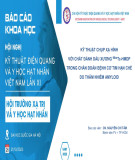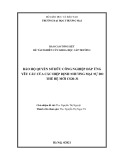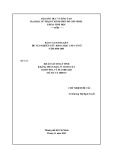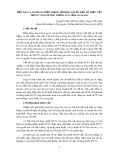
Hindawi Publishing Corporation
EURASIP Journal on Wireless Communications and Networking
Volume 2011, Article ID 313269, 11 pages
doi:10.1155/2011/313269
Research Article
A Feedback-Based Transmission for Wireless Networks with
Energy and Secrecy Constraints
Ioannis Krikidis,1John S. Thompson (EURASIP Member),2
Steve McLaughlin (EURASIP Member),2and Peter M. Grant (EURASIP Member)2
1Department of Computer Engineering & Informatics, University of Patras, Rio, 26500 Patras, Greece
2Institute for Digital Communications, The University of Edinburgh, Mayfield Road, Edinburgh EH9 3JL, UK
Correspondence should be addressed to Ioannis Krikidis, krikidis@ucy.ac.cy
Received 10 July 2010; Revised 29 December 2010; Accepted 19 January 2011
Academic Editor: Lin Cai
Copyright © 2011 Ioannis Krikidis et al. This is an open access article distributed under the Creative Commons Attribution
License, which permits unrestricted use, distribution, and reproduction in any medium, provided the original work is properly
cited.
This paper investigates new transmission techniques for clustered feedback-based wireless networks that are characterized by
energy and secrecy constraints. The proposed schemes incorporate multiuser diversity gain with an appropriate power allocation
(PA) in order to support a defined Quality-of-Service (QoS) and jointly achieve lifetime maximization and confidentiality. We show
that an adaptive PA scheme that adjusts the transmitted power using instantaneous feedback and suspends the transmission when
the required power is higher than a threshold significantly prolongs the network lifetime without affectingtheQoSofthenetwork.
In addition, the adaptation of the transmitted power on the main link improves the secrecy of the network and efficiently protects
the source message from eavesdropper attacks. The proposed scheme improves network’s confidentiality without requiring any
information about the eavesdropper channel and is suitable for practical applications. Another objective of the paper is the energy
analysis of networks by taking into account processing and maintenance energy cost at the transmitters. We demonstrate that the
combination of PA with an appropriate switch-offmechanism, that allows the source to transmit for an appropriate fraction of the
time, significantly extends the network lifetime. All the proposed protocols are evaluated by theoretical and simulation results.
1. Introduction
Recent studies have shown that the Base Station (BS) and
its associated operations are the main cause of power
consumption in the modern wireless networks [1]. This
result in combination with a continuing expansion of the
current networks increases the demands on energy sources
as well as some serious environmental issues like the increase
of CO2emissions to the atmosphere [1,2]. Therefore,
a network design that efficiently uses its available energy
resources is an urgent and important research topic. On the
other hand, due to the broadcast nature of the transmission,
the source message can be received from all the users that
are within the transmission range, and therefore secure
communication is also of importance. In this paper, we focus
on wireless networks with energy and secrecy constraints
and investigate some transmission techniques that improve
network lifetime and confidentiality for users.
Several physical (PHY) layer techniques that decrease
the network’s energy requirements and extend the network
lifetime have been proposed in the literature. In [3,4]
the authors introduce multihop transmission in order to
reduce the energy consumption and they prove that short
intermediate transmissions can result in significant energy
savings. Accordingly, the channel capacity gain that arises
from the cooperative diversity concept also yields a decrease
in the required transmitted power. The energy efficiency
of different relaying techniques is discussed in [5–8], and
several relay selection metrics that incorporate instantaneous
channelfeedback with residual energy in order to achieve
lifetime improvements are presented in [9]. In addition,
appropriate resource allocation strategies can minimize the
energy consumption of a wireless network. The impact of
scheduling on the network lifetime for different levels of
channel knowledge is presented in [10], and several power
allocation (PA) techniques which minimize the average

2 EURASIP Journal on Wireless Communications and Networking
transmission power for different network configurations are
discussed in [11–13]. On the other hand, in addition to
the energy cost associated with the transmission process,
data processing and system maintenance also contribute to
the energy consumption at the transmitters [6]. In [14],
the authors take into account the processing cost and they
prove that dedicated relaying (fixed relaying) is more energy
efficient than user cooperation (mobile relaying). Finally, a
burst transmission system that switches offthe transmitter
for a fraction of time in order to reduce the processing
cost and accumulate energy for future transmissions is
analyzed in [15,16] from an information theoretic stand-
point. However, the quality of the instantaneous link is not
taken into account, and PA as well as QoS issues are not
discussed.
As for secure communication, various PHY layer tech-
niques that increase the perfect secrecy capacity [17,18]ofa
wireless network have recently been investigated. In [19], the
authors propose a joint scheduling and PA scheme in order
to maximize security for a downlink scenario with secrecy
constraints. Another PHY layer approach that employs an
appropriate distributed beamforming design, which forces
the source signal to be orthogonal to the instantaneous
eavesdropper channel, has been reported in [20,21]. The
application of the cooperative (relaying) concept at the PHY
layer as a means to protect the source message from the eaves-
dropper was proposed in [22]. Finally, in [23], the authors
introduce a jammer node that generates artificial interference
in order to confuse the eavesdropper and maximize the
secure rate. However, most of the existing works require
a knowledge of the instantaneous eavesdropper links and
therefore their practical application is limited. Furthermore,
it is worth noting that in the current literature, network
lifetime and PHY layer security are considered as two
separate and independent problems, and therefore existing
solutions may not deal with both issues in the most efficient
way.
In this paper, we investigate some new transmission
techniques that jointly achieve lifetime maximization and
confidentiality improvements. Based on a clustered network
topology with available channel feedback, we investigate two
main transmission techniques that combine the multiuser
diversity (MUD) concept [24], [25, Chapter 6] with an
appropriate PA scheme under a target outage probabil-
ity constraint. The first transmission approach employs a
constant PA scheme and uses the MUD gain in order
to save energy and protect the source message against
potential attacks. The second approach uses more efficiently
the available channel feedback and extracts the MUD
gain by employing an adaptive PA scheme. This adaptive
PA adjusts the transmitted power on the instantaneous
quality of the link and suspends the transmission if the
required power is higher than a selected threshold. We
show that this scheme significantly increases the lifetime
of the network and improves the PHY layer security for
high target outage probabilities. It is worth noting that
the proposed schemes are independent of the eavesdropper
link (in contrast to previously reported work [19,20,23]
which assumes that the instantaneous eavesdropper link can
be estimated) and thus are suitable for practical applica-
tions where the knowledge of the instantaneous source-
eavesdropper link is not available. Another contribution of
the paper is the study of scenarios with high processing
and maintenance cost. An appropriate burst transmission
that switches offthe transmitter for a fraction of time
is integrated to the proposed PA schemes in order to
minimize the total energy cost at the transmitters. We
note that the bursty approach concerns scenarios with high
processing and maintenance cost at the transmitter and
is analyzed from a lifetime standpoint; an overall system
optimization that employs bursty transmission in order
to also establish a secure communication is beyond the
scope of this paper. The lifetime and secrecy performance
of the investigated schemes is analyzed theoretically, and
simulation results validate the enhancements of the proposed
schemes. This work is an extension of our previous work
[26] where an adaptive PA and a routing scheme for
a relaying configuration have been investigated in order
to reduce energy consumption. However, in that work,
MUD techniques, secrecy issues, and processing energy cost
have not been discussed. To the best of our knowledge
the combination of MUD with PA under a defined QoS
constraint and towards a jointly optimization of network’s
lifetime and confidentiality is proposed in this paper for the
first time.
The contribution of the paper is three-fold.
(1) The combination of a constant PA scheme with
the MUD under a predefined QoS constraint. The
extraction of the MUD gain improves both network
lifetime and confidentiality (joint optimization).
(2) The investigation of an adaptive PA scheme that
adjusts the transmitted power to the instantaneous
quality of the channel. MUD gain and adaptive
PA further improve the network lifetime and the
confidentiality of the network (joint optimization).
(3) The development of a bursty transmission mech-
anism that takes into account the processing and
the maintenance cost at the transmitters. Bursty
transmission is combined with the proposed PA
techniques in order to minimize the total energy cost.
It is introduced as an efficient technique to increase
the lifetimeofanetworkwith a high “offline” energy
cost and is analyzed from an energy point of view
(energy optimization).
The remainder of the paper is organized as follows.
Section 2 introduces the system model and presents the basic
assumptions required for the analysis. Section 3 focuses on
the transmission process and analyzes two main PA schemes
in terms of lifetime and secrecy. In Section 4,wefocuson
scenarios with high processing and maintenance cost and
we introduce bursty transmission for further energy savings.
Numerical results are presented and discussed in Section 5,
followed by concluding remarks in Section 6.

EURASIP Journal on Wireless Communications and Networking 3
S
1
k2
E
fS,k
gS,E
.
.
.
K
C
Figure 1: The system model.
2. System Model
In this section, we introduce the network topology and we
present the main assumptions that are used for our analysis.
2.1. Network Topology. We assume a simple configuration
consisting of one source S(i.e., a base station), a cluster
C={1, ...,K}of Kdestinations, and one eavesdropper
node E. The time is considered slotted with each slot having
a unit duration, and, at each time slot, the source transmits
a message to a single destination k∗∈Cbased on a
time-division multiaccess (TDMA) scheme. The source has
an infinite number of messages for each destination, and
each message is transmitted with a rate Rbits per channel
use (BPCU) and considered to be confidential (should be
decoded only by the corresponding destination). Although
the cluster’s nodes are trusted, the Enode, which is within
the transmission coverage of the source node, tries to
overhear (decode) the source message and thus threatens the
confidentiality of the cluster. Figure 1 schematically presents
the system configuration.
2.2. Channel Model. All wireless links exhibit fading and
additive white Gaussian noise (AWGN). The fading is
assumed to be stationary, with frequency nonselective
Rayleigh block fading. This means that the fading coefficients
fS,k(for the S→klink where k∈C)andgS,E(for
the S→Elink) remain constant during one slot but
change independently from one slot to another according to
a circularly symmetric complex Gaussian distribution with
zero mean and variance σ2
fand σ2
g, respectively. Furthermore,
the variance of the AWGN is assumed normalized with
zero mean and unit variance, and the channel power of
the selected link is defined as f∗|fS,k∗|2.Itisworth
noting that the Kdestinations are clustered relatively close
together (location-based clustering) and have the same
average statistics but fade independently in each time slot;
an appropriate clustering algorithm that organizes the nodes
based on average SNR can support this assumption in
practice [27,28]. The instantaneous channel coefficients
fS,kare known at the transmitter node and are estimated
via a continuous training sequence (a feedback channel)
that is transmitted by each node of the cluster. (The base
station transmits a pilot signal which the cluster uses to
estimate SNRs and then feeds back this information to the
base station.) The tracking of the instantaneous channel
quality at the source node via a feedback channel has been
implemented in several modern wireless systems such as
HSDPA and LTE [29].
2.3. Energy Assumptions. An initial energy E0[0] is provided
to the source in order to perform communication, and
E0[n]≥0 denotes the residual energy that remains at
the source node after the nth transmission. If P[n]denotes
the energy cost associated with the nth transmission, the
residual energy is defined as E0[n]=E0[n−1] −P[n].
Due to the normalized slot duration, the measures of energy
and power associated with one slot transmission become
identical and therefore are used equivalently throughout
the paper. The energy cost associated with the channel
feedback (for the tracking of the channel coefficients fS,k
at the transmitter) is considered as a default and fixed cost
for the network and is therefore neglected in the analysis.
It is worth noting that practical systems (e.g., LTE [29],
IEEE 802.11 RTS/CTS [30]) use instantaneous signalling in
order to perform communication, and therefore providing
feedback is not an additional complexity for the system. A
similar assumption is considered in [31], where the energy
consumption related to the RTS/CTS signalling is considered
fixed and neglected in the analysis.
2.4. Network Lifetime—Metric Definition. A main question
that is discussed in this paper is how to maximize the lifetime
of the clustered network considered given a predefined
quality of service (QoS) performance criterion [32,33]. If
we assume that the QoS constraint refers to the maximum
tolerable outage probability η, the optimization problem can
be written as [9]
L(E0[0])=max
nn:Pout ≤η,(1)
where L(E0[0]) denotes the lifetime of the network by using
an initial energy budget E0[0], Pout(·) is the outage prob-
ability of the system, and ndenotes the nth transmission.
Therefore, the lifetime is the time (in terms of time slots)
until the source depletes its available energy, subject to a QoS
constraint (in terms of outage probability).
2.5. Secrecy Definition. According to the principles of the
PHY secrecy channel [17], the source node transmits a
confidential message to the destination node while the eaves-
dropper node, which is within the transmission coverage
of the source node, tries to overhear (decode) the source
message. If we use as a secrecy performance criterion the
secrecy outage probability, defined as the probability that the
instantaneous secure rate is lower than a target secrecy rate

4 EURASIP Journal on Wireless Communications and Networking
RS(where RS≤R), the secrecy performance of the system is
given as [17,18]
Ps-out =Plog1+ptf∗−log1+pt
gS,E
2<R
S,
(2)
where log(·) denotes the base-2 logarithm and ptis the
transmitted power. In contrast to the existing literature
where the minimization of the secrecy outage probability
assumes knowledge of the instantaneous eavesdropper link
(|gS,E|2), here, we are interested in PHY layer techniques
that are independent of the eavesdropper link and therefore
are suitable for practical applications. The secrecy outage
probability is an appropriate design metric when a fixed
(Wyner) code chosen in advance is used for all channel
conditions. However, the practical suitability of this metric
is beyond the scope of this paper and can be found in [34]
(code construction based on secrecy outage probability).
3. MUD and PA towards Lifetime
Maximization and Security
The MUD concept is related to an opportunistic scheduler
(OS) that, at each time, selects as a destination the node
with the strongest channel to the source. According to [24]
and [25, Chapter 6] when channel side information (CSI)
is available at the transmitter, the above scheduling policy
uses more efficiently the common channel resources and
maximizes the total and the individual throughput. The
opportunistic scheduling decision can be written as
k∗=arg max
k∈C
fS,k
2,(3)
where k∗denotes the selected destination. Due to the cluster
configuration considered, where nodes fade independently
but with the same statistics, each node is selected with the
same probability, (due to the symmetric channel model
considered, each node is selected with a probability 1/K
[30]) and therefore fairness as well as latency issues are not
discussed further in this paper. In the following subsections,
we investigate two combinations of the MUD concept with
PA and we discuss the associated lifetime and secrecy
performance.
3.1. A Constant PA Policy. The first approach incorporates
the above MUD concept with a constant PA policy and is
used as a conventional protocol; it is the scheme against
which all the proposed schemes are compared. The source
transmits its message to the selected destination, which has
the strongest link with the source, by using a constant
transmitted power for each transmission. This constant PA
policy is related to the required QoS and corresponds to
the minimum power level that must be transmitted by the
source in order to support the target outage probability.
More specifically, the transmitted power that supports a
target outage probability ηis calculated by solving the outage
probability expression with respect to the transmitted power
as follows:
Plog1+P0f∗<R
=η
=⇒ Pf∗<2R−1
P0=η
=⇒ Y2R−1
P0=η
=⇒ 1−exp−λf
2R−1
P0K
=η
=⇒ P0=λf1−2R
ln1−K
√η,
(4)
where Y(y)[1 −exp(−λfy)]Kdenotes the CDF of the
random variable f∗(by applying order statistics), λf1/σ2
f,
and P0is the transmitted power.
3.1.1. Lifetime Performance. In each transmission slot, the
source selects the node with the best link as a destination and
transmits its message with a constant power P0.Thismeans
that after each transmission, the residual energy is decreased
by P0and therefore the source is active until its residual
power becomes less than P0. Based on this discussion, the
lifetime of the network is defined as
L0=E[0]
P0,(5)
where ⌊x⌋denotes the nearest integer to xtowards zero.
3.1.2. Secrecy Performance. Due to the broadcast nature of
the transmission, the source message is also received by the
eavesdropper node Evia the direct link S→E. The secrecy
performance of MUD with a constant PA is expressed as
Ps-out0 =Plog1+P0f∗−log1+P0g<R
S
=Plog1+P0f∗
1+P0g<R
S
≈Plogf∗
g<R
S
=Pf∗
g<2RS
=V2RS=
K
m=0⎛
⎝
K
m⎞
⎠(−1)mλg
2RSλfm+λg
,
(6)
where V(·) denotes the CDF of the random variable f∗/g
which is given in Appendix A. As can be seen from (6), the
secrecy outage probability of the system does not depend
on the transmitted power P0and therefore is not a function
of the parameter η(different QoS constraints correspond
to the same secrecy performance). On the other hand, we
can see that the OS affects the secrecy performance of the

EURASIP Journal on Wireless Communications and Networking 5
system by decreasing the secrecy outage probability as the
cardinality Kof the cluster increases. Therefore diversity gain
is introduced as an efficient mechanism to protect the source
message without any explicit knowledge of the S→Elink.
3.2. An Instantaneous Channel-Based PA. The second
approach incorporates the MUD with an instantaneous
channel-based PA in order to prolong the network lifetime
and improve the secrecy performance of the system. This
protocol uses channel feedback efficiently, which is available
in the system for the implementation of the MUD, and
adapts the PA policy to the instantaneous channel conditions
without an extra overhead. More specifically, based on the
instantaneous quality of the selected link, the source mea-
sures the minimum required transmitted power/energy in
order to deliver its data correctly to the selected destination.
The required transmitted power can be calculated by the
expression of the instantaneous capacity as follows:
log1+PTf∗=R=⇒ PT=2R−1
f∗,(7)
where PTdenotes the required instantaneous transmitted
power for successful decoding. The combination of the
instantaneous transmitted power PTwith the required
constant transmitted power P0in (4),whichsupportsthe
outage probability constraint η, enables an adaptive PA
policy to be used. This adaptive PA is described by two
cases: (a) the source transmits with a power PTif PT≤P0,
and (b) the source postpones the transmission if PT>P
0.
The basic motivation of this scheme is to avoid scenarios
with wasted power consumption (i.e., the destination cannot
decode the source message or the source transmits with
a power higher than required) and thus to save energy
without affecting the outage or the latency performance of
the constant PA protocol. (The instantaneous channel-based
PA postpones the source transmission when the channel is
in outage therefore the data packet delay (measured in terms
of time slots) is similar to the baseline constant PA scheme;
an unused time slot in the adaptive PA scheme does not
convey any information to the destination in the constant PA
scheme and thus the delay performance is not affecting.) The
adaptive PA policy is formulated as
P1=⎧
⎨
⎩
PTif PT≤P0,
0 elsewhere, (8)
where P1denotes the transmitted power.
3.2.1. Lifetime Performance. According to (8), the transmit-
ted power/energy is a random variable with an average value
that can be calculated as
E[P1]=P0
0ty2R−1, tdt
=Kλf2R−1
×
K−1
m=0K−1
m(−1)mEiλf2R−1(m+1)
P0,
(9)
where Ei(x)∞
xexp(−t)/t dt denotes the exponential
integral and y(·) is the probability density function (PDF)
of the random variable PT, whose derivation is given in
Appendix B. Therefore the lifetime of the network becomes
equal to
L1=E[0]
E[P1].(10)
3.2.2. Secrecy Performance. The secrecy outage probability of
the system can be written as
Ps−out1 =Plog1+P1f∗−log1+P1g<R
S
⎛
⎜
⎜
⎜
⎜
⎜
⎜
⎝
where P1<P
0=⇒ f∗>1
λf
log1
1−K
√η
!
f0
⎞
⎟
⎟
⎟
⎟
⎟
⎟
⎠
=PR−log1+2R−1g
f∗<R
S
=Pf∗
g<2R−RS−1
2R−1
=U1
λf
log1
1−K
√η,2R−1
2R−RS−1,
(11)
where U(·) denotes the cumulative density function (CDF)
of the random variable f∗/gwith f∗>f0and its analytical
expression is given in Appendix A. The above expression
shows that in contrast to the constant PA scheme, here, the
secrecy outage probability also depends on the parameter
P0and therefore on the target outage probability η.
Furthermore, a direct comparison of (6)and(11) reveals that
Ps-out1 <P
s-out0 for moderate values (ηis much greater than
zero.) of ηand the secrecy gain of the instantaneous scheme
becomes larger as the cardinality of the cluster Kincreases
(the function Ψ(f0)in(
A.1)ofAppendix A is an increasing
function with respect to the parameters ηand K). This
observation demonstrates that the combination of the MUD
concept with an instantaneous PA policy jointly improves the
lifetime and the secrecy performance (for moderate values
of η) of the network. Furthermore, the improvement in the
secrecy performance is achieved without any interaction with
the eavesdropper link (i.e., estimation of the instantaneous
S→Elink), and therefore the instantaneous PA policy is
introducedasanefficient practical PHY layer technique for
systems with secrecy limitations (in practical systems the
location of the eavesdropper node is unknown).
For extremely small values of η(η→0), the threshold
f0tends to zero ( f0→0) and, according to Appendix A,
U(0, x)=V(x). For this special case, we have that
Ps-out1 ≈V2R−1
2R−RS−1≥V2RS=Ps-out0
as RS≥0⇐⇒ 2R−1
2−RS·2R−1≥2RS,
(12)








![Vaccine và ứng dụng: Bài tiểu luận [chuẩn SEO]](https://cdn.tailieu.vn/images/document/thumbnail/2016/20160519/3008140018/135x160/652005293.jpg)







![Báo cáo seminar chuyên ngành Công nghệ hóa học và thực phẩm [Mới nhất]](https://cdn.tailieu.vn/images/document/thumbnail/2025/20250711/hienkelvinzoi@gmail.com/135x160/47051752458701.jpg)









